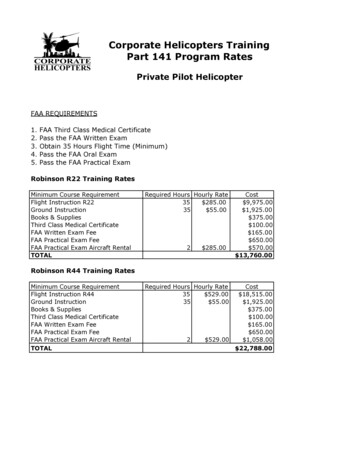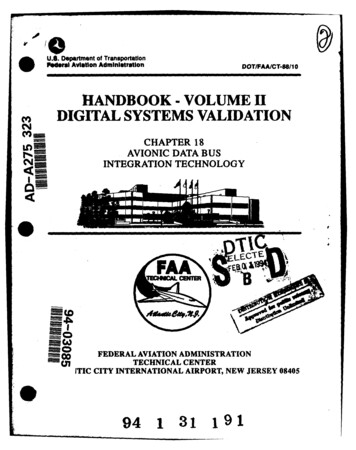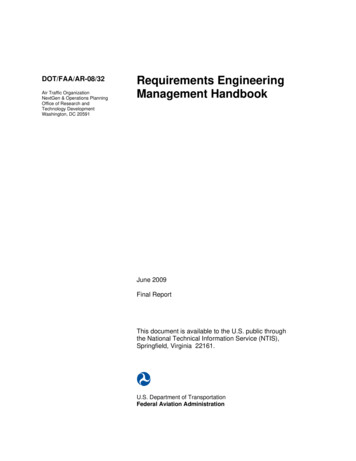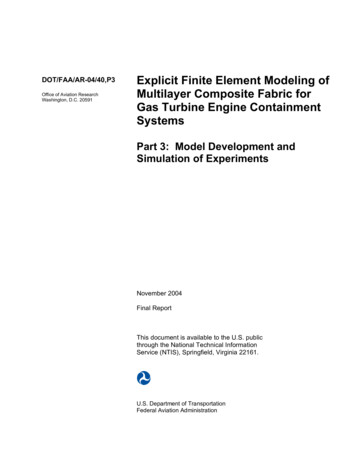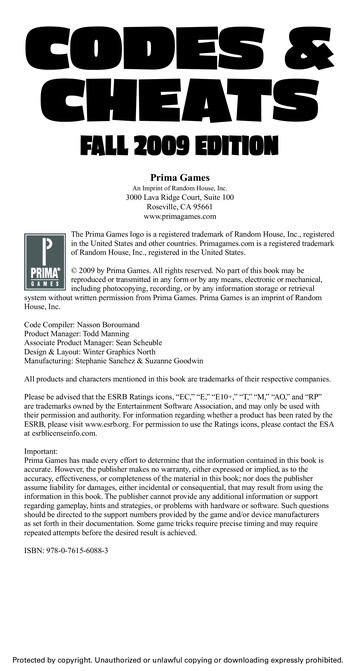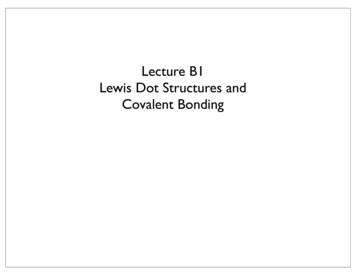
Transcription
DOT/FAA/AM-00/7Office of Aviation MedicineWashington, DC 20591The Human FactorsAnalysis and ClassificationSystem–HFACSScott A. ShappellFAA Civil Aeromedical InstituteOklahoma City, OK 73125Douglas A. WiegmannUniversity of Illinois at Urbana-ChampaignInstitute of AviationSavoy, IL 61874February 2000Final ReportThis document is available to the publicthrough the National Technical InformationService, Springfield, Virginia 22161.U.S. Depar tmentof Transpor tationFederal AviationAdministration
N O T I C EThis document is disseminated under the sponsorship ofthe U.S. Department of Transportation in the interest ofinformation exchange. The United States Governmentassumes no liability for the contents thereof.
Technical Report Documentation Page1. Report No.2. Government Accession No.3. Recipient's Catalog No.DOT/FAA/AM-00/74. Title and Subtitle5. Report DateThe Human Factors Analysis and Classification System—HFACSFebruary 20006. Performing Organization Code7. Author(s)8. Performing Organization Report No.12Shappell, S.A. , and Wiegmann, D.A.9. Performing Organization Name and Address10. Work Unit No. (TRAIS)1FAA Civil Aeromedical Institute, Oklahoma City, OK 73125University of Illinois at Urbana-Champaign, Institute of Aviation,Savoy, Ill. 61874211. Contract or Grant No.99-G-00612. Sponsoring Agency name and Address13. Type of Report and Period CoveredOffice of Aviation MedicineFederal Aviation Administration800 Independence Ave., S.W.Washington, DC 2059114. Sponsoring Agency Code15. Supplemental NotesThis work was performed under task # AAM-A –00-HRR-52016. AbstractHuman error has been implicated in 70 to 80% of all civil and military aviation accidents. Yet, most accidentreporting systems are not designed around any theoretical framework of human error. As a result, mostaccident databases are not conducive to a traditional human error analysis, making the identification ofintervention strategies onerous. What is required is a general human error framework around which newinvestigative methods can be designed and existing accident databases restructured. Indeed, a comprehensivehuman factors analysis and classification system (HFACS) has recently been developed to meet those needs.Specifically, the HFACS framework has been used within the military, commercial, and general aviation sectorsto systematically examine underlying human causal factors and to improve aviation accident investigations.This paper describes the development and theoretical underpinnings of HFACS in the hope that it will helpsafety professionals reduce the aviation accident rate through systematic, data-driven investment strategies andobjective evaluation of intervention programs17. Key Words18. Distribution StatementAviation, Human Error, Accident Investigation, DatabaseAnalysisDocument is available to the public through theNational Technical Information Service,Springfield, Virginia 2216119. Security Classif. (of this report)UnclassifiedForm DOT F 1700.7 (8-72)20. Security Classif. (of this page)UnclassifiedReproduction of completed page authorizedi21. No. of Pages1822. Price
THE HUMAN FACTORS A NALYSIS AND CLASSIFICATION SYSTEM–HFACSINTRODUCTIONfact, even the identification of a “primary” cause isfraught with problems. Rather, aviation accidents arethe end result of a number of causes, only the last ofwhich are the unsafe acts of the aircrew (Reason, 1990;Shappell & Wiegmann, 1997a; Heinrich, Peterson, &Roos, 1980; Bird, 1974).The challenge for accident investigators and analystsalike is how best to identify and mitigate the causalsequence of events, in particular that 70-80 % associated with human error. Armed with this challenge, thoseinterested in accident causation are left with a growinglist of investigative schemes to chose from. In fact, thereare nearly as many approaches to accident causation asthere are those involved in the process (Senders &Moray, 1991). Nevertheless, a comprehensive framework for identifying and analyzing human error continues to elude safety professionals and theorists alike.Consequently, interventions cannot be accurately targeted at specific human causal factors nor can theireffectiveness be objectively measured and assessed. Instead, safety professionals are left with the status quo.That is, they are left with interest/fad-driven researchresulting in intervention strategies that peck around theedges of accident causation, but do little to reduce theoverall accident rate. What is needed is a frameworkaround which a needs-based, data-driven safety program can be developed (Wiegmann & Shappell, 1997).Sadly, the annals of aviation history are littered withaccidents and tragic losses. Since the late 1950s, however, the drive to reduce the accident rate has yieldedunprecedented levels of safety to a point where it is nowsafer to fly in a commercial airliner than to drive a car oreven walk across a busy New York city street. Still, whilethe aviation accident rate has declined tremendouslysince the first flights nearly a century ago, the cost ofaviation accidents in both lives and dollars has steadilyrisen. As a result, the effort to reduce the accident ratestill further has taken on new meaning within bothmilitary and civilian aviation.Even with all the innovations and improvementsrealized in the last several decades, one fundamentalquestion remains generally unanswered: “Why do aircraft crash?” The answer may not be as straightforwardas one might think. In the early years of aviation, it couldreasonably be said that, more often than not, the aircraftkilled the pilot. That is, the aircraft were intrinsicallyunforgiving and, relative to their modern counterparts,mechanically unsafe. However, the modern era of aviation has witnessed an ironic reversal of sorts. It nowappears to some that the aircrew themselves are moredeadly than the aircraft they fly (Mason, 1993; cited inMurray, 1997). In fact, estimates in the literature indicate that between 70 and 80 percent of aviation accidents can be attributed, at least in part, to human error(Shappell & Wiegmann, 1996). Still, to off-handedlyattribute accidents solely to aircrew error is like tellingpatients they are simply “sick” without examining theunderlying causes or further defining the illness.So what really constitutes that 70-80 % of humanerror repeatedly referred to in the literature? Somewould have us believe that human error and “pilot” errorare synonymous. Yet, simply writing off aviation accidents merely to pilot error is an overly simplistic, if notnaive, approach to accident causation. After all, it iswell established that accidents cannot be attributedto a single cause, or in most instances, even a singleindividual (Heinrich, Petersen, and Roos, 1980). InReason’s “Swiss Cheese” Model of Human ErrorOne particularly appealing approach to the genesis ofhuman error is the one proposed by James Reason(1990). Generally referred to as the “Swiss cheese”model of human error, Reason describes four levels ofhuman failure, each influencing the next (Figure 1).Working backwards in time from the accident, the firstlevel depicts those Unsafe Acts of Operators that ultimately led to the accident1. More commonly referred toin aviation as aircrew/pilot error, this level is where mostaccident investigations have focused their efforts andconsequently, where most causal factors are uncovered.1Reason’s original work involved operators of a nuclear power plant. However, for the purposes of this manuscript, theoperators here refer to aircrew, maintainers, supervisors and other humans involved in aviation.1
After all, it is typically the actions or inactions of aircrewthat are directly linked to the accident. For instance,failing to properly scan the aircraft’s instruments whilein instrument meteorological conditions (IMC) or penetrating IMC when authorized only for visual meteorological conditions (VMC) may yield relativelyimmediate, and potentially grave, consequences. Represented as “holes” in the cheese, these active failures aretypically the last unsafe acts committed by aircrew.However, what makes the “Swiss cheese” modelparticularly useful in accident investigation, is that itforces investigators to address latent failures within thecausal sequence of events as well. As their name suggests,latent failures, unlike their active counterparts, may liedormant or undetected for hours, days, weeks, or evenlonger, until one day they adversely affect the unsuspecting aircrew. Consequently, they may be overlooked byinvestigators with even the best intentions.Within this concept of latent failures, Reason described three more levels of human failure. The firstinvolves the condition of the aircrew as it affects performance. Referred to as Preconditions for Unsafe Acts, thislevel involves conditions such as mental fatigue andpoor communication and coordination practices, oftenreferred to as crew resource management (CRM). Notsurprising, if fatigued aircrew fail to communicate andcoordinate their activities with others in the cockpit orindividuals external to the aircraft (e.g., air traffic control, maintenance, etc.), poor decisions are made anderrors often result.OrganizationalInfluencesBut exactly why did communication and coordination break down in the first place? This is perhapswhere Reason’s work departed from more traditionalapproaches to human error. In many instances, thebreakdown in good CRM practices can be tracedback to instances of Unsafe Supervision, the third levelof human failure. If, for example, two inexperienced(and perhaps even below average pilots) are pairedwith each other and sent on a flight into knownadverse weather at night, is anyone really surprised bya tragic outcome? To make matters worse, if thisquestionable manning practice is coupled with thelack of quality CRM training, the potential for miscommunication and ultimately, aircrew errors, ismagnified. In a sense then, the crew was “set up” forfailure as crew coordination and ultimately performance would be compromised. This is not to lessen therole played by the aircrew, only that intervention andmitigation strategies might lie higher within the system.Reason’s model didn’t stop at the supervisory leveleither; the organization itself can impact performance at all levels. For instance, in times of fiscalausterity, funding is often cut, and as a result, training and flight time are curtailed. Consequently, supervisors are often left with no alternative but to task“non-proficient” aviators with complex tasks. Notsurprisingly then, in the absence of good CRM training, communication and coordination failures willbegin to appear as will a myriad of other preconditions, all of which will affect performance and elicitaircrew errors. Therefore, it makes sense that, if theaccident rate is going to be reduced beyond currentlevels, investigators and analysts alike must examinethe accident sequence in its entirety and expand itbeyond the cockpit. Ultimately, causal factors at alllevels within the organization must be addressed ifany accident investigation and prevention system isgoing to succeed.In many ways, Reason’s “Swiss cheese” model ofaccident causation has revolutionized common viewsof accident causation. Unfortunately, however, it issimply a theory with few details on how to apply it ina real-world setting. In other words, the theory neverdefines what the “holes in the cheese” really are, atleast within the context of everyday operations. Ultimately, one needs to know what these system failuresor “holes” are, so that they can be identified duringaccident investigations or better yet, detected andcorrected before an accident occurs.Latent FailuresUnsafeSupervisionLatent FailuresPreconditionsforUnsafe ActsLatent FailuresUnsafeActsActive FailuresFailed orAbsent DefensesMishapFigure 1. The “Swiss cheese” model of humanerror causation (adapted from Reason, 1990).2
The balance of this paper will attempt to describethe “holes in the cheese.” However, rather than attempt to define the holes using esoteric theories withlittle or no practical applicability, the original framework (called the Taxonomy of Unsafe Operations) wasdeveloped using over 300 Naval aviation accidentsobtained from the U.S. Naval Safety Center (Shappell& Wiegmann, 1997a). The original taxonomy hassince been refined using input and data from othermilitary (U.S. Army Safety Center and the U.S. AirForce Safety Center) and civilian organizations (National Transportation Safety Board and the FederalAviation Administration). The result was the development of the Human Factors Analysis and Classification System (HFACS).their intended outcome. Not surprising, given thefact that human beings by their very nature makeerrors, these unsafe acts dominate most accidentdatabases. Violations, on the other hand, refer to thewillful disregard for the rules and regulations thatgovern the safety of flight. The bane of many organizations, the prediction and prevention of these appalling and purely “preventable” unsafe acts, continueto elude managers and researchers alike.Still, distinguishing between errors and violationsdoes not provide the level of granularity required ofmost accident investigations. Therefore, the categories of errors and violations were expanded here(Figure 2), as elsewhere (Reason, 1990; Rasmussen,1982), to include three basic error types (skill-based,decision, and perceptual) and two forms of violations(routine and exceptional).THE HUMAN FACTORS ANALYSIS ANDCLASSIFICATION SYSTEMErrorsDrawing upon Reason’s (1990) concept of latentand active failures, HFACS describes four levels offailure: 1) Unsafe Acts, 2) Preconditions for UnsafeActs, 3) Unsafe Supervision, and 4) OrganizationalInfluences. A brief description of the major components and causal categories follows, beginning with thelevel most closely tied to the accident, i.e. unsafe acts.Skill-based errors. Skill-based behavior within thecontext of aviation is best described as “stick-andrudder” and other basic flight skills that occur without significant conscious thought. As a result, theseskill-based actions are particularly vulnerable to failures of attention and/or memory. In fact, attentionfailures have been linked to many skill-based errorssuch as the breakdown in visual scan patterns, taskfixation, the inadvertent activation of controls, andthe misordering of steps in a procedure, among others(Table 1). A classic example is an aircraft’s crew thatbecomes so fixated on trouble-shooting a burned outwarning light that they do not notice their fatalUnsafe ActsThe unsafe acts of aircrew can be loosely classifiedinto two categories: errors and violations (Reason,1990). In general, errors represent the mental orphysical activities of individuals that fail to rorsViolationsPerceptualErrorsFigure 2. Categories of unsafe acts committed by aircrews.3RoutineExceptional
TABLE 1. Selected examples of Unsafe Acts of Pilot Operators (Note: This is nota complete listing)ERRORSSkill-based ErrorsBreakdown in visual scanFailed to prioritize attentionInadvertent use of flight controlsOmitted step in procedureOmitted checklist itemPoor techniqueOver-controlled the aircraftDecision ErrorsImproper procedureMisdiagnosed emergencyWrong response to emergencyExceeded abilityInappropriate maneuverPoor decisionVIOLATIONSFailed to adhere to briefFailed to use the radar altimeterFlew an unauthorized approachViolated training rulesFlew an overaggressive maneuverFailed to properly prepare for the flightBriefed unauthorized flightNot current/qualified for the missionIntentionally exceeded the limits of the aircraftContinued low-altitude flight in VMCUnauthorized low-altitude canyon runningPerceptual Errors (due to)Misjudged distance/altitude/airspeedSpatial disorientationVisual illusionexperience, and educational background, the mannerin which one carries out a specific sequence of eventsmay vary greatly. That is, two pilots with identicaltraining, flight grades, and experience may differsignificantly in the manner in which they maneuvertheir aircraft. While one pilot may fly smoothly withthe grace of a soaring eagle, others may fly with thedarting, rough transitions of a sparrow. Nevertheless,while both may be safe and equally adept at flying, thetechniques they employ could set them up for specificfailure modes. In fact, such techniques are as much afactor of innate ability and aptitude as they are anovert expression of one’s own personality, makingefforts at the prevention and mitigation of techniqueerrors difficult, at best.Decision errors. The second error form, decisionerrors, represents intentional behavior that proceedsas intended, yet the plan proves inadequate or inappropriate for the situation. Often referred to as “honest mistakes,” these unsafe acts represent the actionsor inactions of individuals whose “hearts are in theright place,” but they either did not have the appropriate knowledge or just simply chose poorly.descent into the terrain. Perhaps a bit closer to home,consider the hapless soul who locks himself out of thecar or misses his exit because he was either distracted,in a hurry, or daydreaming. These are both examplesof attention failures that commonly occur duringhighly automatized behavior. Unfortunately, whileat home or driving around town these attention/memory failures may be frustrating, in the air theycan become catastrophic.In contrast to attention failures, memory failuresoften appear as omitted items in a checklist, placelosing, or forgotten intentions. For example, most ofus have experienced going to the refrigerator only toforget what we went for. Likewise, it is not difficultto imagine that when under stress during inflightemergencies, critical steps in emergency procedurescan be missed. However, even when not particularlystressed, individuals have forgotten to set the flaps onapproach or lower the landing gear – at a minimum,an embarrassing gaffe.The third, and final, type of skill-based errorsidentified in many accident investigations involvestechnique errors. Regardless of one’s training,4
Perhaps the most heavily investigated of all errorforms, decision errors can be grouped into threegeneral categories: procedural errors, poor choices,and problem solving errors (Table 1). Proceduraldecision errors (Orasanu, 1993), or rule-based mistakes, as described by Rasmussen (1982), occur during highly structured tasks of the sorts, if X, then doY. Aviation, particularly within the military andcommercial sectors, by its very nature is highly structured, and consequently, much of pilot decisionmaking is procedural. There are very explicit procedures to be performed at virtually all phases of flight.Still, errors can, and often do, occur when a situationis either not recognized or misdiagnosed, and thewrong procedure is applied. This is particularly truewhen pilots are placed in highly time-critical emergencies like an engine malfunction on takeoff.However, even in aviation, not all situations havecorresponding procedures to deal with them. Therefore, many situations require a choice to be madeamong multiple response options. Consider the pilotflying home after a long week away from the familywho unexpectedly confronts a line of thunderstormsdirectly in his path. He can choose to fly around theweather, divert to another field until the weatherpasses, or penetrate the weather hoping to quicklytransition through it. Confronted with situationssuch as this, choice decision errors (Orasanu, 1993),or knowledge-based mistakes as they are otherwiseknown (Rasmussen, 1986), may occur. This is particularly true when there is insufficient experience,time, or other outside pressures that may precludecorrect decisions. Put simply, sometimes we chosewell, and sometimes we don’t.Finally, there are occasions when a problem is notwell understood, and formal procedures and responseoptions are not available. It is during these ill-definedsituations that the invention of a novel solution isrequired. In a sense, individuals find themselveswhere no one has been before, and in many ways,must literally fly by the seats of their pants. Individuals placed in this situation must resort to slow andeffortful reasoning processes where time is a luxuryrarely afforded. Not surprisingly, while this type ofdecision making is more infrequent then other forms,the relative proportion of problem-solving errorscommitted is markedly higher.Perceptual errors. Not unexpectedly, when one’sperception of the world differs from reality, errorscan, and often do, occur. Typically, perceptual errorsoccur when sensory input is degraded or “unusual,”as is the case with visual illusions and spatial disorientation or when aircrew simply misjudge the aircraft’saltitude, attitude, or airspeed (Table 1). Visual illusions, for example, occur when the brain tries to “fillin the gaps” with what it feels belongs in a visuallyimpoverished environment, like that seen at night orwhen flying in adverse weather. Likewise, spatialdisorientation occurs when the vestibular systemcannot resolve one’s orientation in space and therefore makes a “best guess” — typically when visual(horizon) cues are absent at night or when flying inadverse weather. In either event, the unsuspectingindividual often is left to make a decision that is basedon faulty information and the potential for committing an error is elevated.It is important to note, however, that it is not theillusion or disorientation that is classified as a perceptual error. Rather, it is the pilot’s erroneous responseto the illusion or disorientation. For example, manyunsuspecting pilots have experienced “black-hole”approaches, only to fly a perfectly good aircraft intothe terrain or water. This continues to occur, eventhough it is well known that flying at night over dark,featureless terrain (e.g., a lake or field devoid of trees),will produce the illusion that the aircraft is actuallyhigher than it is. As a result, pilots are taught to relyon their primary instruments, rather than the outsideworld, particularly during the approach phase offlight. Even so, some pilots fail to monitor theirinstruments when flying at night. Tragically, theseaircrew and others who have been fooled by illusionsand other disorientating flight regimes may end upinvolved in a fatal aircraft accident.ViolationsBy definition, errors occur within the rules andregulations espoused by an organization; typicallydominating most accident databases. In contrast,violations represent a willful disregard for the rulesand regulations that govern safe flight and, fortunately, occur much less frequently since they ofteninvolve fatalities (Shappell et al., 1999b).5
While there are many ways to distinguish betweentypes of violations, two distinct forms have been identified, based on their etiology, that will help the safetyprofessional when identifying accident causal factors.The first, routine violations, tend to be habitual bynature and often tolerated by governing authority (Reason, 1990). Consider, for example, the individual whodrives consistently 5-10 mph faster than allowed by lawor someone who routinely flies in marginal weatherwhen authorized for visual meteorological conditionsonly. While both are certainly against the governingregulations, many others do the same thing. Furthermore, individuals who drive 64 mph in a 55 mph zone,almost always drive 64 in a 55 mph zone. That is, they“routinely” violate the speed limit. The same can typically be said of the pilot who routinely flies into marginal weather.What makes matters worse, these violations (commonly referred to as “bending” the rules) are oftentolerated and, in effect, sanctioned by supervisory authority (i.e., you’re not likely to get a traffic citationuntil you exceed the posted speed limit by more than 10mph). If, however, the local authorities started handingout traffic citations for exceeding the speed limit on thehighway by 9 mph or less (as is often done on militaryinstallations), then it is less likely that individuals wouldviolate the rules. Therefore, by definition, if a routineviolation is identified, one must look further up thesupervisory chain to identify those individuals in authority who are not enforcing the rules.On the other hand, unlike routine violations, exceptional violations appear as isolated departures fromauthority, not necessarily indicative of individual’s typical behavior pattern nor condoned by management(Reason, 1990). For example, an isolated instance ofdriving 105 mph in a 55 mph zone is considered anexceptional violation. Likewise, flying under a bridge orengaging in other prohibited maneuvers, like low-levelcanyon running, would constitute an exceptional violation. However, it is important to note that, while mostexceptional violations are appalling, they are not considered “exceptional” because of their extreme nature.Rather, they are considered exceptional because they areneither typical of the individual nor condoned by authority. Still, what makes exceptional violations particularly difficult for any organization to deal with isthat they are not indicative of an individual’s behavioralrepertoire and, as such, are particularly difficult topredict. In fact, when individuals are confronted withevidence of their dreadful behavior and asked toexplain it, they are often left with little explanation.Indeed, those individuals who survived such excursions from the norm clearly knew that, if caught, direconsequences would follow. Still, defying all logic,many otherwise model citizens have been down thispotentially tragic road.Preconditions for Unsafe ActsArguably, the unsafe acts of pilots can be directlylinked to nearly 80 % of all aviation accidents. However,simply focusing on unsafe acts is like focusing on a feverwithout understanding the underlying disease causingit. Thus, investigators must dig deeper into why theunsafe acts took place. As a first step, two major subdivisions of unsafe aircrew conditions were developed:substandard conditions of operators and the substandard practices they commit (Figure 3).PRECONDITIONSFORUNSAFE ACTSSubstandardConditions StatesSubstandardPractices ofOperatorsPhysical/MentalLimitationsFigure 3. Categories of preconditions of unsafe acts.6Crew ResourceMismanagementPersonalReadiness
Substandard Conditions of OperatorsAdverse mental states. Being prepared mentally iscritical in nearly every endeavor, but perhaps evenmore so in aviation. As such, the category of AdverseMental States was created to account for those mentalconditions that affect performance (Table 2). Principal among these are the loss of situational awareness,task fixation, distraction, and mental fatigue due tosleep loss or other stressors. Also included in thiscategory are personality traits and pernicious attitudes such as overconfidence, complacency, and misplaced motivation.Predictably, if an individual is mentally tired forwhatever reason, the likelihood increase that an errorwill occur. In a similar fashion, overconfidence andother pernicious attitudes such as arrogance andimpulsivity will influence the likelihood that a violation will be committed. Clearly then, any frameworkof human error must account for preexisting adversemental states in the causal chain of events.Adverse physiological states. The second category,adverse physiological states, refers to those medical orphysiological conditions that preclude safe operations (Table 2). Particularly important to aviation aresuch conditions as visual illusions and spatial disorientation as described earlier, as well as physical fatigue, and the myriad of pharmacological and medicalabnormalities known to affect performance.The effects of visual illusions and spatial disorientation are well known to most aviators. However, lesswell known to aviators, and often overlooked are theeffects on cockpit performance of simply being ill.Nearly all of us have gone to work ill, dosed withover-the-counter medications, and have generallyperformed well. Consider however, the pilot suffering from the common head cold. Unfortunately,most aviators view a head cold as only a minorinconvenience that can be easily remedied usingover-the counter antihistamines, acetaminophen, andother non-prescription pharmaceuticals. In fact, when7
confronted with a stuffy nose, aviators typically areonly concerned with the effects of a painful sinusblock as cabin altitude changes. Then again, it is notthe overt symptoms that local flight surgeons areconcerned with. Rather, it is the accompanying innerear infection and the increased likelihood of spatialdisorientation when entering instrument meteorological conditions that is alarming - not to mentionthe side-effects of antihistamines, fatigue, and sleeploss on pilot decision-making. Therefore, it is incumbent upon any safety professional to account for thesesometimes subtle medical conditions within the causalchain of events.Physical/Mental Limitations. The third, and final,substandard condition involves individual physical/mental limitations (Table 2). Specifically, this category refers to those instances when mission requirements exceed the capabilities of the individual at thecontrols. For example, the human visual system isseverely limited at night; yet, like driving a car,drivers do not necessarily slow down or take additional precautions. In aviation, while slowing downisn’t always an option, paying additional attention tobasic flight instruments and increasing one’s vigilance will often increase the safety margin. Unfortunately, when precautions are not taken, the result canbe catastrophic, as pilots will often fail to see otheraircraft, obstacles, or power lines due to the size orcontrast of the object in the visual field.Similarly, there are occasions when the time required to complete a task or maneuver exceeds anindividual’s capacity. In
human factors analysis and classification system (HFACS) has recently been developed to meet those needs. Specifically, the HFACS framework has been used within the military, commercial, and general aviation sectors to systematically examine underlying human causal
